Medicinal plants in the Baviaanskloof
Medicinal plants are an important aspect of the South African cultural heritage. Southern Africa has well over 30 000 species of plants. The Cape Floral Kingdom has nearly 9 000 species, and is the most diverse temperate flora on earth, rivalling the tropical rainforest in terms of its species richness. With South Africa’s remarkable biodiversity and cultural diversity, it is not surprising to find that approximately 3000 species of plants are used as medicines. Of these, some 350 species are the most commonly used in trade medicinal plants.
Each system or medicine is the art and science of diagnosing the cause of disease, treating disease and maintaining health in the broadest sense of physical, spiritual, social and psychological well-being. Methods of administration include orally, topically, steaming, sublingually, nasally, bathing, rectally and smoking.
Traditional knowledge is a key element of sustainable development, particularly in relation to plant medicine and agriculture, which may offer solutions and cures to pandemics such as AIDS and cancer, as well as to various other health problems. Traditional knowledge enables society to relate to a value system that they understand and appreciate, and leads to community members’ participation of building the quality of life they cherish. There is significant loss of knowledge every time an old knowledgeable person dies without leaving a record of their knowledge and experience. The loss of traditional knowledge has a direct effect on the depletion of fauna and flora and the degradation of the habitats and ecosystems generally.
An inventory of some of the medicinal and edible plants of Baviaanskloof and their associated uses is provided below to shed some light on the traditional knowledge of natural healing with plants in the Baviaanskloof. See the book “Medicinal plants of South Africa” by Van Wyk and Gericke for a detailed botanical description, plant parts used, preparation and dosage, active ingredients, pharmacological effects and distribution of these plants. Medical terminology is explained at the end of this chapter.
Acacia karoo (Camel thorn, sweet thorn, Fabaceae family)

This tree’s growth form varies from a multi-stemmed shrub to a tree of up to 15 meters in height. The leaves are bipinnately compound, with narrow oblong leaflets. Its flowers are sweetly scented, golden-yellow balls, and the fruits are slender woody pods, sickle-shaped and slightly constricted between the seeds. Acacia trees are a dominant species in the valley-bushveld vegetation type, but also occur in thicket and gorges.
Humans have found ways of using almost every part of this tree. Infusions of the bark and leaves are an old Cape remedy for dysentery and diarrhoea. The gum, which has a pleasant though slightly sour taste, is relished by many people. It has been used as an adhesive, in confectionery (production of sweets) and as a treatment for oral thrush. The inner bark is pliable when wet, and a strong rope can be made from it. Tannin from the bark is used for tanning leather, and adds a red hue to it. The wood is used for making furniture and in some parts of Africa, the thorns are used as needles. Apart from these uses, Acacia karoo has provided shade, fuel and protection from wild animals for centuries.
Leaves, flowers and seedpods are edible, but it is especially the young leaves and shoots that are relished by many game species. Infusions of the bark are given to cattle as an antidote to poisoning by certain Moraea species (a genus of plants with poisonous bulbs). The bark and leaves are a Cape remedy for diarrhoea and dysentery. The gum, bark and leaves have also been used as an emollient and astringent for colds, conjunctivitis and haemorrhage. Larvae of charaxes butterflies, hairtail butterflies and spotted blue butterflies are dependent on the young shoots and thorns for survival.
Aloe ferox (Aalwyn, Asphodelaceae family)
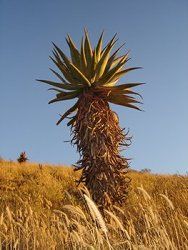
Aloe ferox, the largest and most visible aloe in the area, is used extensively for medicinal purposes. The leaves or roots are used as a laxative and in the treatment of arthritis, eczema and stress. The sap from the leaves is used to treat acne, burning wounds and skin irritations. The trade (international and local) of Aloe ferox leaf sap and products is sustaining a large number of people. Aloe tappers traditionally gather the juice of Aloe ferox to sell on the pharmaceutical market. It is a family trade that gets passed down from one generation to the next in the Western and Eastern Cape. Tappers from the Uniondale district travel to farms in the Baviaanskloof area annually to tap aloes, and live nomadically between farms whilst doing so. They cut the elongated triangular leaves from aloes and place them on top of each other in a circle to form a catchment area in the middle where the sap is subsequently collected.
Boophane disticha (Gifbol, Bushman poison bulb, Amaryllidaceae family)

The dry outer scales of the bulb are used as an outer dressing after circumcision and are also applied to boils or septic wounds (often mixed with water, milk or oil) to alleviate pain and to “draw out” the pus. Very weak decoctions of the bulb scales are used as an effective sedative. Higher doses induce visual hallucinations, which are sometimes used for divination and even higher doses can be fatal.
Carpobrotus edulis (Suurvygie, Sour Fig, Mesembryanthemceae family)

This species grows on the ground. It is a succulent, and flowers are large pink and yellow, depending on the species. The fruits of Carpobrotus species are edible, and can be eaten either fresh or in dried form. A very popular preserve is made from the fruits, and is highly sought after as an ingredient in Eastern cooking. Sap from the leaves is used to treat insect bites on the skin, as well as minor skin ailments such as pimples or rash. Leaf juice is gargled to treat infections of the mouth and throat. It is also taken orally for dysentery, digestive troubles, tuberculosis and as a diuretic and styptic. It is applied externally to treat eczema, wounds and burns. It is also said to be highly effective against toothache, earache and oral and vaginal thrush.
Cotyledon orbiculata (Plakkie, Pig's Ear, Crassulaceae family)
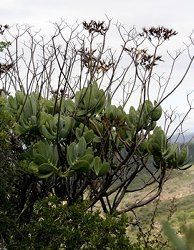
The fleshy part of the leaf is applied to corns and warts to soften and remove them. A single leaf is eaten as a vermifuge. The warmed leaf sap is used as drops for earache and toothache. The juice has been used to treat epilepsy.
Dodonaea angustifolia (Sandolie, Sand Olive, Sapondaceae family)

The sand olive is a shrub or small tree that grows in the fynbos biome on top of the mountains, but also occurs interspersed in valley bushveld vegetation, as well as in riparian habitats close to water. Its leaves are narrow and elliptic with a shiny light-green colour. It has inconspicuous yellow-green flowers, and the fruit are winged to facilitate wind dispersal.
This plant is used to consolidate sand in many countries. Early records claim that sand olive effectively treats tuberculosis, skin rashes and fever. A decoction of the leaves is an early Cape remedy for fever, and is still widely used to treat colds, influenza, stomach troubles, rheumatism and as a gargle for sore throats and oral thrush.
Elytropappus rhinecerotis (Renosterbos, Asteraceae family)
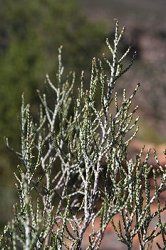
Infusions of the young branches in brandy or wine are a traditional Cape remedy for indigestion, ulcers and stomach cancer. It is also taken as a tonic to improve appetite. A local superstition is that the Karoo paralysis tick is only poisonous when it occurs where renosterbos is abundant.
Ficus sur (Wildevy, Wild fig, Moraceae family)
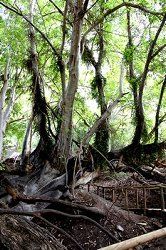
The wild fig is certainly one of the most magnificent tree species to be appreciated in the Baviaanskloof, with its root system growing above the ground in spiralling masses, and its trunks growing high up into a forest canopy that lures monkeys and birds to its sweet fruits. Its way of life is to sink its roots into a shallow water source, and it therefore occupies spaces next to rivers, dams and fountains.
The leaves are elliptic to ovate with irregularly toothed margins. A distinguishable feature of this tree is the figs that grow in leafless clusters of branchlets growing from the trunk, the main branches, and occasionally from the roots.
The wood is used for furniture, drums and, in the past, for the brake blocks of ox-wagons. Although usually infected by insects, the fruit is tasty and is eaten fresh or sun-dried. The figs are a favourite meal of birds, bats, monkeys and ants. An infusion of the root is used to treat infertility in both sexes. The powdered root is taken orally to treat nose bleeds. The latex is dripped directly onto the eye to treat cataracts.
Grewia robusta (Kruisbessie, Tiliaceae family)
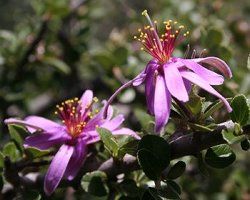
This is a very beautiful shrub that grows up to three meters high. Its leaves are alternately arranged, with the underside covered in minute hairs. It carries attractive pink flowers, and the fruit are small and green, and arranged in a characteristic cross shape.
Many Grewia species are found throughout the Karoo and the Kalahari. Bushmen used these shrubs to manufacture bow arrows from the stems, and rope from the fibrous bark. The fruit is edible and has been used as a basis for brewing beer.
Leonotus leonurus (Wilde dagga, Lamiaceae family)
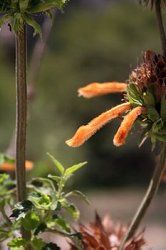
This herb grows as a multi-stemmed shrub, up to 1.50 m. It sometimes occurs on mountain slopes, but prefers the moist conditions found close to mountain streams inside a gorge. Leaf infusions are taken for colds, flu, bronchitis, asthma and headaches. Leonitus leonurus contains the same diterpenoid lactones that are also found in the European white horehound (Marrubium vulgare), which is traditionally used as a coughing medicine. Leaves are smoked to treat epilepsy. Leaves and roots are widely used as a remedy for snake bite and other bites and stings. Externally, decoctions have been applied to treat boils, eczema, skin diseases, itching and muscular cramps. Internally, decoctions are used for coughs, colds, influenza, bronchitis, high blood pressure and headaches. Leaf infusions have been used for asthma and viral hepatitis.
Pappea capensis (Doppruim, Jacket Plum, daceae family)

This tree is characteristic of the mountain slopes at Sederkloof Lodge. It is a small to medium-sized tree, often with an umbrella shape resulting from the removal of its lower branches by browsers. The leaves are simple, oblong and alternately arranged. Its flowers are arranged in spike-like heads, scented and yellowish-green. The male and female flowers occur on separate trees. The fruit is a green capsule, later splitting open to reveal orange-red flesh.
The fruit is used to make jelly and jam. The edible oil has been used to oil rifles and to make soap. The jacket plum provides good fodder for livestock and game. Most frugivorous birds visit this tree. Larvae of pearl-spotted charaxes butterfly and brown playboy butterfly live on the tree and serve as pollinators.
Pelargonium species (Malva, Geraniaceae family)

At least four species of Pelargonium occur at Sederkloof Lodge. They have stunning pink, cream or white flowers, and usually grow in riparian vegetation close to mountain streams. A few species grow on top of the mountains in Fynbos vegetation. Pelargoniums are internationally acclaimed garden plants, and some South African species are water-wise plants, meaning they are good to plant because they can grow with only a little water. Many garden hybrids have been developed from this Southern African group, especially in Europe. The tubers of Pelargoniums are used medicinally. P. reniforme and P. sidoides (both not found in Baviaanskloof) are ingredients of a german medicine called ‘Umckaloaba’, which is used to treat bronchitis in children. Infusions of the tubers are used to treat diarrhoea and dysentery.
Pellaea calomelanos (Hard fern, Adiantaceae family)
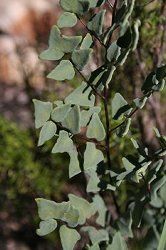
The leaves can be smoked for head colds, chest colds and asthma. Decoctions of the rhizomes are used to treat boils and abscesses, and for intestinal parasites. Other species such as Cheilanthes sp. can be smoked to relieve head and chest colds. This fern likes to grow in between rock crevices on rough mountain slopes, but also in wet conditions in a ravine.
Table 1: Glossary of medical terms |
|
|
Term |
Meaning |
|
Anti-diuretic |
A substance that prevents the discharge of urine. |
|
Astringent |
A substance that causes contraction of body tissue and blood vessels. |
|
Conjunctivitis |
Inflammation of the conjunctiva of the eye – commonly “pink-eye”. |
|
Diuretic |
A substance that increases the discharge of urine. |
|
Dysentery |
Diarrhoea associated with blood, puss or mucous in the stool, indicating a bacterial parasitic infection. |
|
Dyspepsia |
Indigestion |
|
Emetic |
A substance that causes vomiting. |
|
Expectorant |
A substance promoting secretion or expulsion of mucous from the respiratory system. |
|
Emollient |
An agent that softens and soothes, especially the skin. |
|
Infusion |
Infusions are prepared by macerating the crude drug for a short period of time in cold or boiling water. Infusions are liable to fungus and bacterial growth and should be used within 12 hours of their preparation. |
|
Hypertension |
Abnormally high blood pressure. |
|
Oedema |
Swollen state of tissue caused by accumulation of fluids between cells. |
|
Styptic |
An agent that arrests bleeding, usually due to its astringent quality. |
|
Vermifuge |
An agent that destroys or causes the expulsion of parasitic worms. |
|
Table 2: Some other medicinal plants found at Sederkloof Lodge. Please ask your guide to point them out to you. |
|
|
Artemisia afra Asteraceae Wildeals African wormwood |
Treats numerous ailments – mainly coughs, colds and influenza – but also fever, loss of appetite, colic, headache, earache, malaria and intestinal worms. The most common practise is to insert fresh leaves into the nostrils to clear blocked nasal passages. |
|
Ballota africana Lamiaceae Kattekruid |
Originates from the Khoi cultures, who used it to treat measles and fevers. Infusions or brandy tinctures are used to treat colds, influenza, asthma, bronchitis, hoarseness, heart trouble, hysteria, insomnia, headaches, liver problems, piles and as a foot bath for arthritis. |
|
Eriocephalus africanus Asteraceae Kapokbos Wild rosemary |
Beneficial for heart disease, including heart failure. Used by Khoi people as a diuretic to treat oedema (dropsy) and for stomach ache. |
|
Euclea undulata Ebenaceae Gewone gwarrie Common guarrie |
Infusions of the roots are used to treat heart diseases, headache and toothache. Anti-inflammatory properties. |
|
Helichrysum species Asteraceae Imphepho Kooigoed |
Many ailments are treated with these popular medicinal plants; including fever, coughs, colds, infections, headache and menstrual pain. It is a popular ingredient for wound dressings. |
|
Melianthus comosus Meliantemaceae Kruidjie-roer-my-nie |
Leaf poultices and leaf decoctions are widely used to treat septic wounds, sores, bruises, backache and rheumatic joints. Traditional remedy for snake bite. Root infusions are used for treating cancer, and strong leaf decoctions are applied topically for ringworm. |
|
Mentha longifolia Lamiaceae Kruisement Wild mint |
Main use is for coughs, colds, asthma and other respiratory problems. Also used to treat headaches, fevers, indigestion, flatulence, hysteria, painful menstruation, delayed pregnancy and for urinary tract infections. Externally, it has been used to treat wounds and swollen glands. |
|
Ocotea bullata Lauraceae Stinkhout Black stinkwood |
Finely ground, the bark is used as a snuff or the smoke is inhaled to relieve headaches. It is also used as a local application to the area of the bladder in urinary disorders, and is claimed to be beneficial for stomach trouble and as an emetic for emotional and nervous disorders. |
|
Olea europaea Oleaceae Olienhout Wild olive |
Main use is a hypotensive to lower blood pressure and to enhance renal function. An infusion of the fresh bark is taken to relieve colic, while infusions of the leaves are widely used as eye lotions. Decoctions are gargled to treat sore throats. |
|
Peucedanum galbanum Apiaceae Bergseldery Blister bush |
The main use of the plant is to treat kidney and bladder ailments. Other traditional uses include treatments of rheumatism, water retention, glandular swelling and high blood pressure. A brandy tincture of the leaves is an early Cape remedy for obesity in men. |
|
Pittosporum viridiflorum Pittosporaceae Kasuur Cheesewood |
Decoctions or infusions are widely used to treat stomach complaints, biliousness, abdominal pain and fever. It is said to ease pain and have a calming effect. |
|
Plumbago auriculata Plumbaginaceae Syselbos |
The powdered roots or leaves are snuffed to relieve headache. Various other uses have been recorded, such as the removal of warts and the treatment of fractures. |
|
Protea repens Proteaceae Suikerbos Sugar bush |
The syrup produced from the nectar, known as “bossiestroop”, was an important Cape remedy for chest disorders and formed an ingredient of cough mixtures. It was also used to treat diabetes. The bark of P. caffra is used to treat bleeding stomach ulcers and diarrhoea. |
|
Psidium guajava Myrtaceae Koejawel Guava |
Guava leaves are commonly used in South Africa as a remedy for diarrhoea. The leaves are also used for several ailments, including diabetes, fever, cough, ulcers, boils and wounds. The main ethnographic use in Africa is said to be for malaria. Leaf infusions are used in the Cape for diabetes. |
|
Rapanea melanophloeos Myrsinaceae Kaapse boekenhout Cape beech |
Decoctions of the bark are used by the Zulu as expectorants and emetics, and also against muscular pain, stomach disorders and to strengthen the heart. |
|
Rhus undulata Anacardiaceae Koeniebos Kuni-bush |
Traditional uses include the chewing of leaves for chest colds by the Nama people, and leaf decoctions for post partem problems. The roots are claimed to be of therapeutic value in infective disorders of the gastro-intestinal tract. The bark and leaves of several other species are used medicinally, including R. burchellii, R. chirendensis, R. laevigata and R. viminalis. |
|
Salix mucronata Salicaceae Wilde wilger Wild willow |
Willow tips are traditionally used in many parts of South Africa to treat rheumatism and fever. |
|
Schotia brachypetala Fabaceae Huilboerboon Weeping boer-bean |
A decoction of the bark is reported to be taken (as an emetic) to treat heartburn and the effects of too much drinking. Bark mixtures are also used to strengthen the body and for a facial sauna. The bark and root may be used to treat diarrhoea, or, in Venda, nervous heart conditions. |
|
Tarchonanthus camphoratus Asteraceae Wildekamferbos Wild camphor bush |
Infusions and tinctures of the leaves and twigs are used for stomach trouble, abdominal pain, headache, toothache, asthma, bronchitis and inflammation. A hot poultice on the chest is said to give relief from the ailments mentioned above. Smoke or fumes from the fried or fresh plant are inhaled for asthma, headache and rheumatism. There are historic records of the Khoi and San people smoking the dried leaves like tobacco, apparently with a slight narcotic effect. |
|
Viscum capense Viscaceae Voëlent Cape mistletoe |
An early Cape remedy for diarrhoea, which was taken as a herbal tea substitute. It is also a traditional medicine for asthma, bronchitis, and excessive or irregular menstruation. Infusions of the fruits were used to stop bleeding and to remove warts. |
